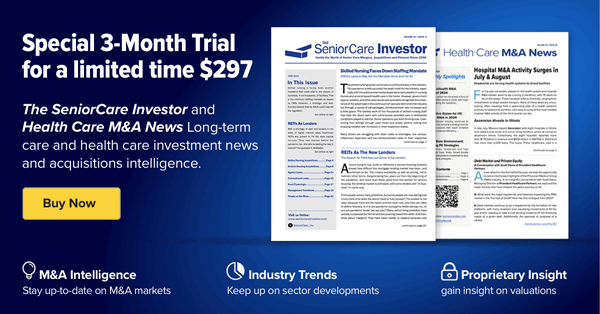The first half of 2022 revealed a shift away from the pandemic-fueled activity in the Home Health & Hospice (HH&H) M&A market seen during 2020 and 2021. This trend has carried through to the third quarter of 2022, which included 25 deals, a 43% drop from 2021’s third quarter when there were 44 announced transactions in the sector.
Through the end of the third quarter this year, there have been 83 transactions announced in the HH&H sector, which covers the categories of home health, home hospice, palliative care, durable medical equipment, respiratory home care, geriatric care management, personal care, home aides and multi-service providers. Deals this year have fallen 24% since 2021, when 109 transactions were announced between Q1 and Q3.
The most active HH&H subsector has been home health with nine deals during Q3, making up approximately 36% of all HH&H deals in the quarter. During the first nine months of 2022 there have been 31 home health transactions, making up 37.34% of all HH&H acquisitions. The second most active subsectors were a tie between Home Hospice and Palliative Care, with 16 transactions announced YTD and six QTD, and Durable Medical Equipment/Respiratory Home Care, with 16 transactions announced YTD and six QTD. And, let’s not forget Palliative Care, which had a very active first half of 2022 (13 deals announced) but has since come to a screeching halt with no acquisitions announced during Q3.
The most active acquirer in the HH&H sector during Q3 has been InHome Therapy, with three transactions announced since July.
In July, the company acquired Remedy Therapy Staffing, a home health company based in Austin, Texas, and North Texas Home Therapy Professionals, a contract home health company that provides in-home physical, occupational and speech therapy services. In August, InHome Therapy acquired Advanced Healthcare Services, which offers at-home physical, occupational and speech therapy services to patients in Springfield, Illinois.
The HH&H sector also continues to be flooded with capital from private equity firms seeking to grow their market share and enter new markets. This includes H.I.G. Capital-backed St. Croix Hospice’s acquisition of Corpore Sano Hospice, Limerston Capital-backed Trinity Home Care purchasing Premier Homecare and Ridgemont Equity Partners’ portfolio company Agape Care Group acquiring GHC Hospice. All of these were executed in the third quarter of 2022, and the trend is expected to continue through the end of the year.
With a hawkish federal reserve continuing to raise interest rates amid persistently high inflation, many dealmakers are tightening their belts. Although deal flow slowed during the third quarter, there were a few notable strategic deals bringing values up.
The most notable of these big-budget deals was retail pharmacy and healthcare giant CVS Health’s acquisition of Signify Health for $30.50 per share in cash, representing a transaction value of approximately $8 billion.
A major issue facing the home health industry is staffing shortages that continue to hamper the sector as hospitals and other employers lure home health workers away with better pay and benefits. Home health care workers are among the lowest paid, making it even harder to retain a loyal, happy staff. Many home care aides have left the industry to pursue more competitive compensation in other fields, and those who remain are seeking higher pay.
Labor accounts for a significant majority of home health business expenses. This topic was brought up at McDermott Will & Emery’s HPE New York event, which our LevinPro HC editorial team attended on October 21st. With the future of wage inflation up in the air, higher wages among service-intensive healthcare sectors, such as home health, will keep some private equity buyers from making moves in the industry. This is especially concerning as an aging population means reliance on paid caregivers is expected to increase over the next few years. According to the U.S. Bureau of Labor Statistics, openings for these positions are expected to increase almost 37% by 2028.
Although M&A activity has fallen in the HH&H sector, it does not tell the entire story.
The pandemic resulted in a growing preference for at-home care among many people, especially aging and chronically ill patients who are looking to remain at home and avoid high-cost hospitals or skilled nursing facilities. Driving this trend are patients who do not require intensive medical supervision, yet have high rates of chronic illnesses. As COVID cases continue to linger across the country, flu season approaches and risk remains higher among certain populations and patients who may wish to avoid more populated settings, in-home care will continue to be a growing and viable option.
Despite the M&A slowdown in recent months, uncertainty revolving around CMS reimbursement changes, fluctuating valuations and staffing shortages, there is still much optimism in the HH&H sector. It will be interesting to observe if such a robust market can handle all the uncertainties being thrown its way over the coming months and years, or if it will crumble under the pressure.


